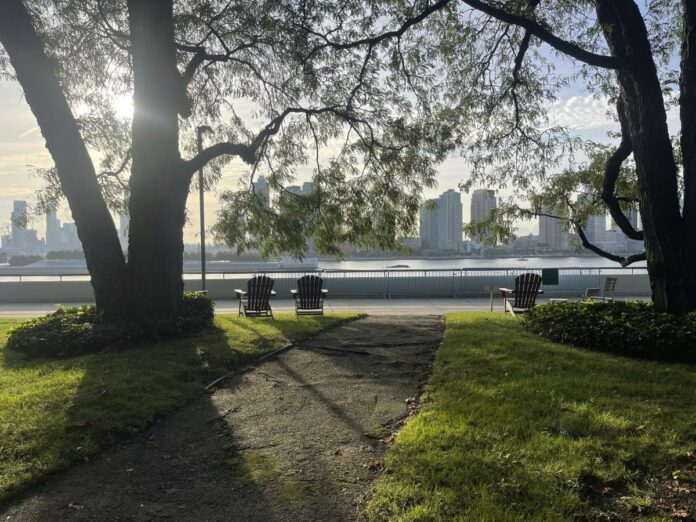UNITED NATIONS (AP) — Inside, with speeches and machinations and carefully deployed elbows, those who administer the world persist in their search for the elusive path to peace. Outside, on the wooded grounds of a place founded on the premise of ending conflict, sometimes they can find it.
In the walled-off compound of the United Nations at the easternmost end of Manhattan, north of the towering Secretariat Building and the majestic General Assembly Hall, sits a quiet patch of wooded land that exists in placid contrast to the global cauldron of diplomacy and national interests a few hundred feet away.
There are garden paths ringed by a canopy of trees so isolating that it’s easy to forget the massive metropolis just beyond the fence — until you arrive at a clearing, look up and see buildings that touch the sky. Around every bend are tiny rewards — a copse of trees with the Olympic rings poking out, a tiny reflecting-pool shrine that exhorts people to “remember here those who gave their lives for peace.”
At the edge of the East River, Adirondack chairs sit facing outward toward the shores of the New York City borough of Queens. In front of a nearby bush, a sign implores: “Please do not feed the geese.” Said geese were nowhere in sight.
And there is, unexpectedly and delightfully, a small and well-hidden basketball court where quick pickup games can convene. On one day early this week, a man in a suit stood quietly tossing a foam ball into the hoop; on Friday morning, a lone pigeon stood sentinel.
PEACE, LARGE AND SMALL
Few speeches from world leaders this week have failed to mention peace, the key reason the United Nations exists and also one of its central and much-vaunted Sustainable Development Goals, whose deadline is 2030. “Bring lasting peace,” said Pravind Jugnauth, prime minister of Mauritius. Malaysian Prime Minister Anwar Ibrahim spoke of “the imperative to make peace.” Stevo Pendarovski, president of North Macedonia, called peace “the fundament of everything.”
“Collective and pressing action,” said Tonga Prime Minister Siaosi Sovaleni, “can only be achieved in the presence of trust and enduring peace.”
The peace mentioned in those speeches is of a larger variety — the absence of war and violence and anger, and perhaps the absence of poverty and inequity as well. That’s a tall order. But small-form peace can be hard to come by, too, particularly if you’re a diplomat or a U.N. employee working in one of the most unremittingly 24/7 towns on Earth.
Tiny oases at abound at the edge of the U.N.’s most high-profile chambers and work rooms. There’s the quiet library on the Secretariat Building’s ground floor filled with actual physical books that extend back to the U.N.’s early years. There’s a meditation area, and there are little outdoor chairs and tables at the compound’s south end. Together they offer a pleasing counterbalance for moments of contemplation — something quite imperative in the quest for the larger kind of peace.
Each morning this week since the leaders’ meeting convened Tuesday, you could see that sensibility play out as delegates from sundry backgrounds wandered through the little park, took in the river view, paused at the reflecting pool.
A CONTRAST BETWEEN HUSTLE AND HUSH
Though the grounds are not open to the public for security reasons, higher-profile visitors have taken advantage of the setting over the years. In July, visiting Indian Prime Minister Narendra Modi used the North Lawn, adjacent to the wooded area, to perform yoga poses as part of his visit. He joined hundreds of yoga aficionados for 35 minutes of exercises and meditation.
Even without organized activities, though, the patch of land offers ample space for private meditation — an unexpected combination of the global vastness that the United Nations represents and the small-form intimacy of a park, something that so many New Yorkers appreciate in patches of green across the city.
It’s easy to forget that just a few yards away this week, humanity’s contentious and sometimes bloody dramas are playing out — from India and Pakistan to Armenia and Azerbaijan to Russia and Ukraine — as diplomats attempt to replace open conflict with the more mannered activities of diplomacy and, ultimately, lasting peace.
Along one path in the park, you look back and see, through the trees, the imposing view of the two main U.N. buildings towering over the rest of the compound. Then you come around the bend and see the little basketball court, and are reminded of some things easily forgotten this week inside the bustling halls: The Earth is not merely a planet of work and warfare; it is a place of placidity and play, too. The people trying to figure all this out are just that — people.
And the bird perched at the edge of the court? It’s not the dove of peace. That would be too easy. It’s just the basketball-court pigeon of the East River. But for one tranquil moment, for one brief respite from the world’s most high-stakes conversations, that’s more than sufficient.
___
Ted Anthony, the director of new storytelling and newsroom innovation at The Associated Press, has been writing about international affairs since 1995 and covering the U.N. General Assembly’s leaders meetings since 2018. Find him at http://twitter.com/anthonyted


